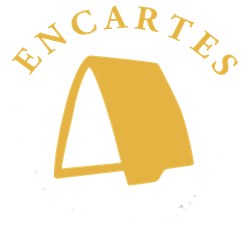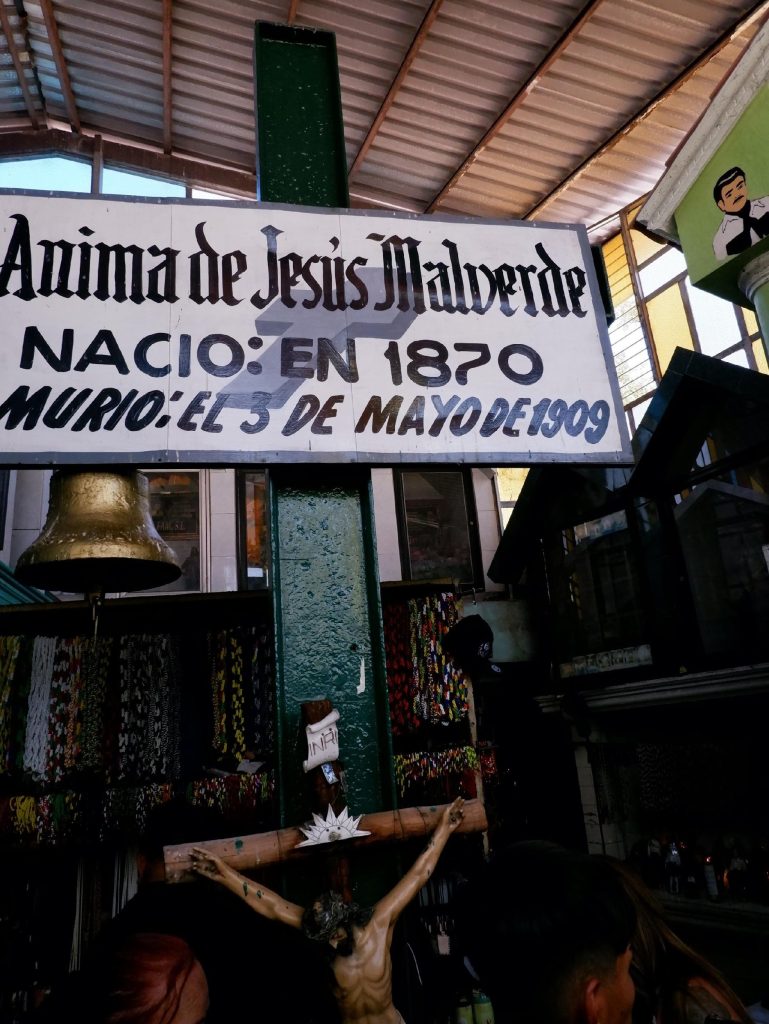
Image 1. The Holy Cross of Malverde
Culiacán, Sinaloa, May 3, 2024
Jesús Malverde was a bandit born in northwestern Mexico at the end of the 19th century. He died at the hands of the forces of order commanded by General Cañedo, then governor of Sinaloa. After his death, hanging from a mesquite tree, he was instructed not to bury his remains so that, not receiving a Christian burial, he could not rest in peace. Malverde's soul in pain has found in his devotees different forms of gratitude. One of them is to materialize this gratitude for the favors received; at some point, this gratitude was manifested in raising the steel cross shown in the photograph.
Image 2. Malverde's images
Culiacán, Sinaloa, May 3, 2024
It is a set of religious figures of Jesus Malverde. Most of them are images of the bust of the character, although there are others in which he is seated on an armchair/throne. There are also necklaces, medals, rosaries and scapulars with the image of the saint's face. The largest figure stands out for being the authentic central image of the main niche of the chapel of Malverde, which is concentrated with so many other images in the hood of the van, property of the chapel to carry out the traditional tour through the surrounding streets.
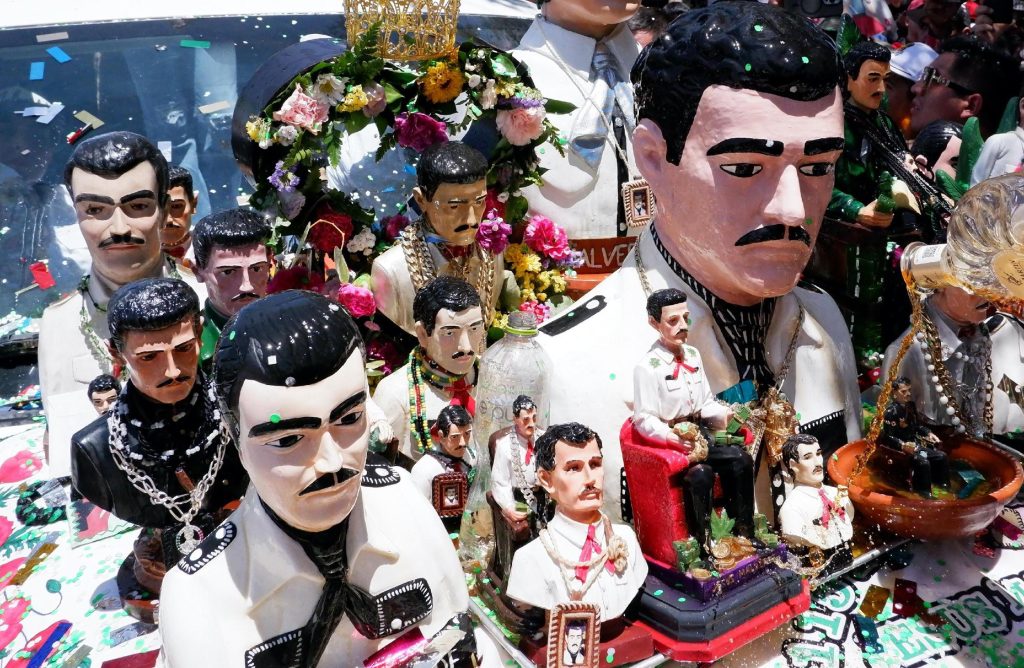
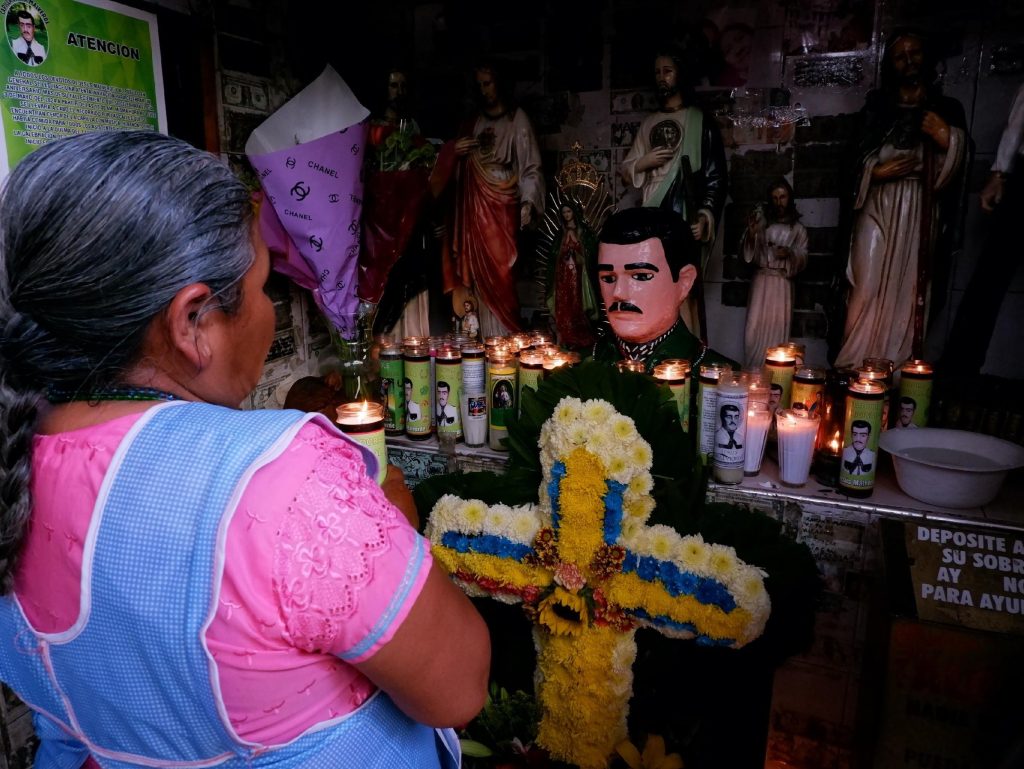
Image 3. Images of Malverde II
Culiacán, Sinaloa, May 3, 2024
In this photograph, inside the chapel, an original reproduction of the bust of Jesus Malverde can be seen, but unlike the one in the main niche, in this image he wears a green shirt and, around his neck, the handkerchief is black and white. Behind him, there are dollars and photographs taped with tape. Between the wall of the niche and the image of Malverde are other images of the Catholic faith, such as the Virgin of Guadalupe, St. Jude Thaddeus and Jesus Christ. Both in the devotee's hand and surrounding the saint are candles with the image and the prayer to Malverde. In front, with her back turned, is a woman; women are increasingly taking a more central role in the cult of Malverde.
Image 4. The freighter of the Divine Providence Rider
Culiacán, Sinaloa, May 3, 2024
One type of errand often carried by Mexican cargo carriers -usually related to carnival and patron saint festivities- is to carry a carnival or pyrotechnics bull. The photo shows a person, a volunteer, carrying the image of the generous bandit on his horse, which is fixed to a metal structure that facilitates its transportation. During the procession different devotees have taken turns to carry the rider; and in the rests there are those who approach to give him liquor or beer to drink.
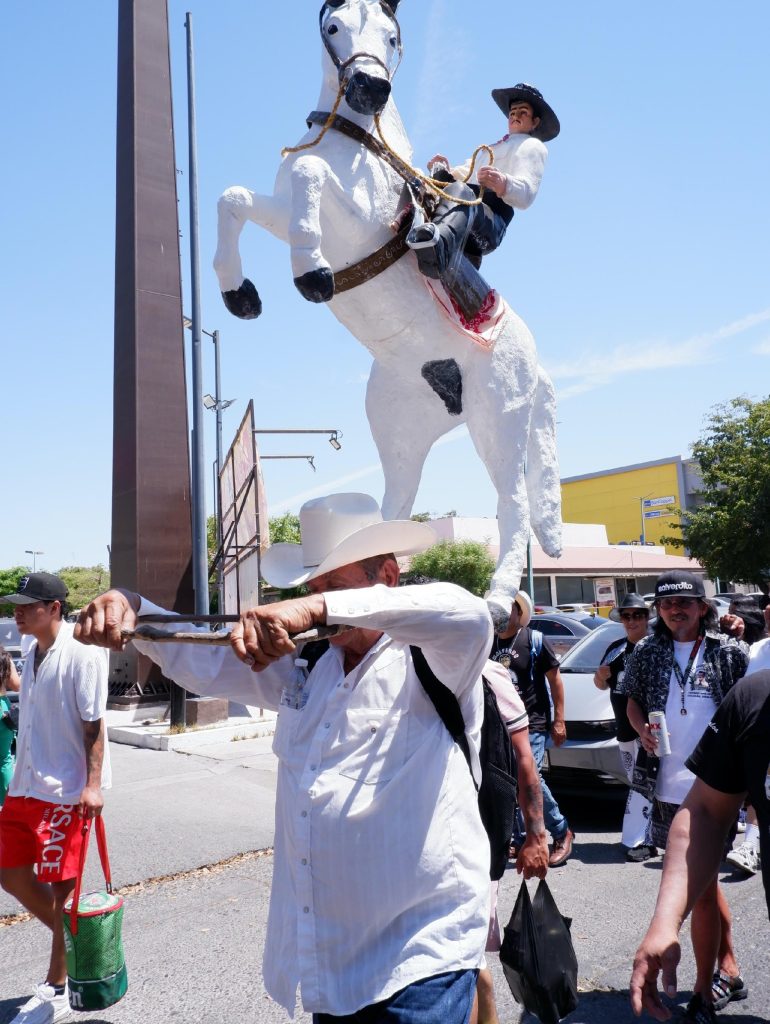
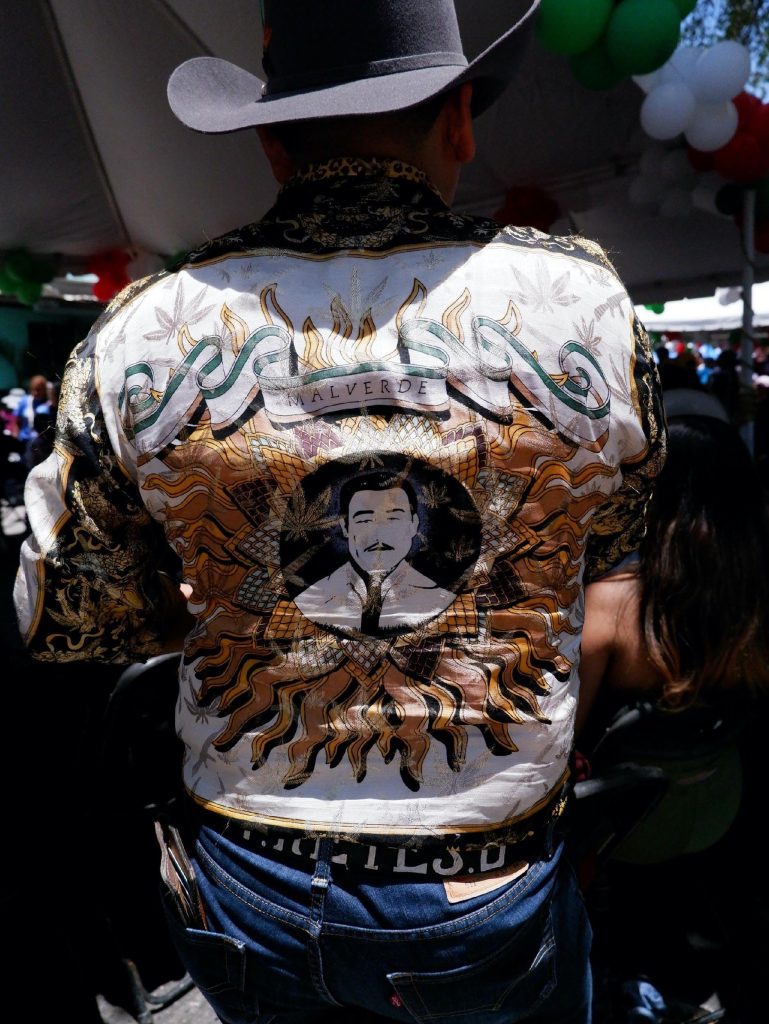
Image 5. Malverdista fashion
Culiacán, Sinaloa, May 3, 2024
Caps, hats, sombreros, belts or cowboy shirts bearing the image of Malverde are merchandise that, outside the festive context, have a more profane meaning; however, during the festivity they are endowed with sacredness, as they are part of the sacred meaning of the image of Malverde. In this photo, a freighter with his back turned shows the detail of the image of Jesus Malverde surrounded by marijuana leaves and, in the center, a sunflower.
Image 6. Tattoos
Culiacán, Sinaloa, May 3, 2024
A constant in the annual celebration of the cult of Malverde are the tattoos that are carried on the chest, back and arms, mainly. However, in this photo the innovative aspect is the gender of the bearer. It is relevant that more and more women are showing their Malverde tattoos during the festivity. Particularly, this photo focuses on the face of the character without offering more detail of his clothing. The representation of the Virgin of Guadalupe, half-length behind the saint, stands out.
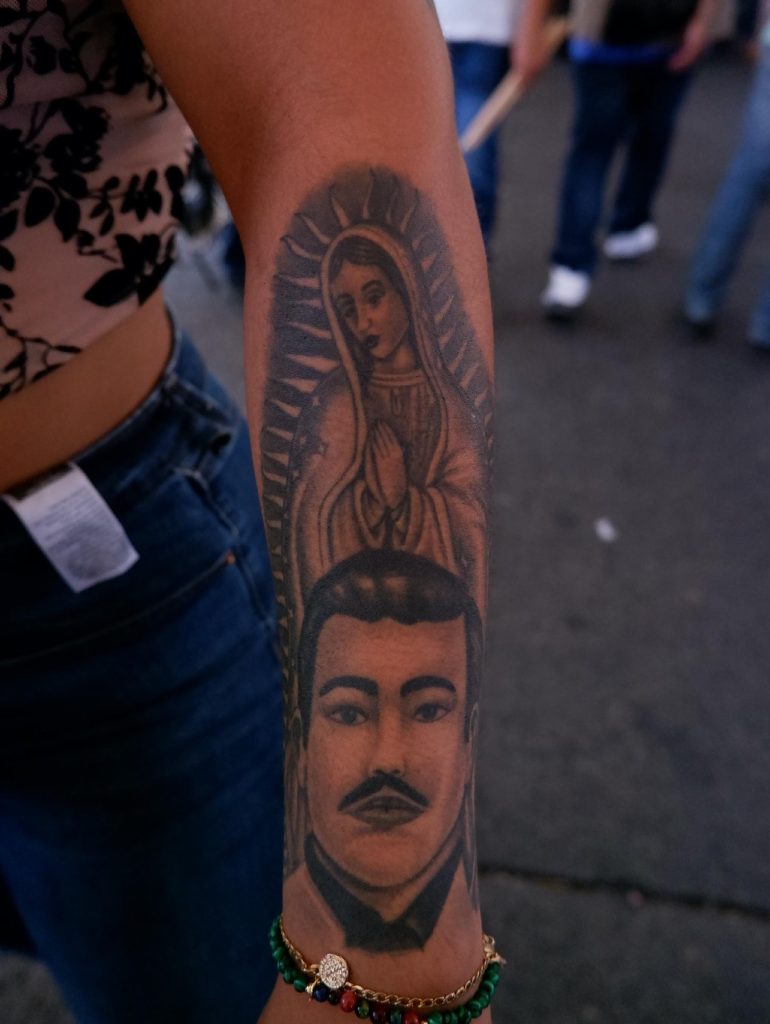
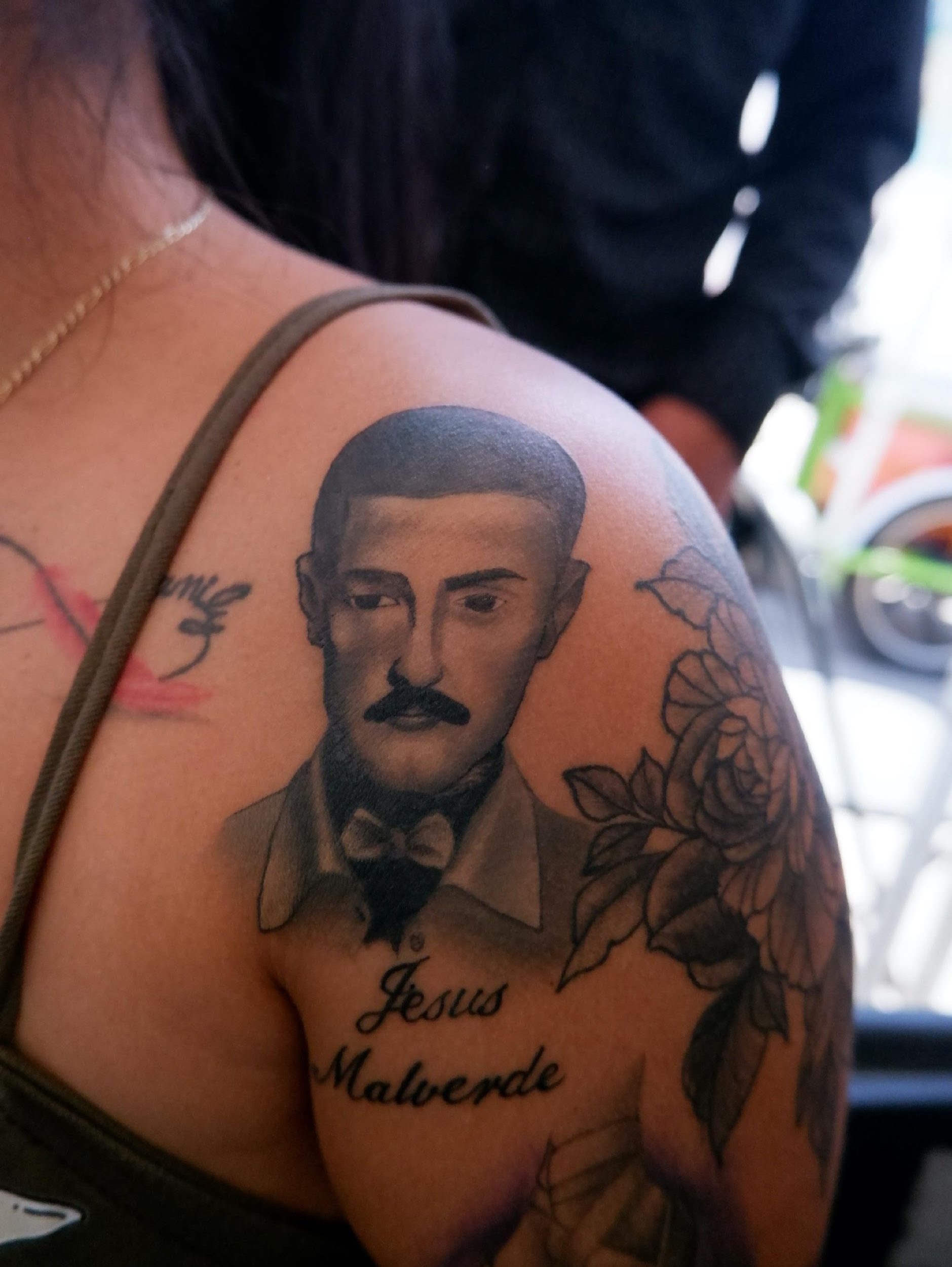
Image 7. Tattoos II
Culiacán, Sinaloa, May 3, 2024
A tattoo of Malverde on the shoulder of a woman, in which he wears a small bow tie instead of the tie he traditionally wears. Again, the portrait focuses on his face. Underneath, "Jesús Malverde" is inscribed. This piece is surrounded by other tattoos with no allusions to the religious or spiritual life of the adherent. It is about a woman who, by devotion or by some command, exhibits her tattoo during the festivity. Whether they are cargueras, pilgrims who accompany the saint on their knees in his procession or through their tattoos, among other elements of sacredness or malverdista spirituality, on this occasion the female category has acquired greater relevance.
Image 8. Tattoos III
Culiacán, Sinaloa, May 3, 2024
In the case of men, the continued use of tattoos as a way to pay for a favor has remained almost a tradition during the May 3 holiday. In previous years, the tattoos were placed on parts of the body that are usually covered, such as the chest, back or legs. This photo shows a variation in this spiritual practice, as the image of Malverde is more frequently seen tattooed on the forearm. The photograph shows Malverde's face and that he wears a bow tie and a shirt. Behind the saint is St. Jude Thaddeus, showing half of his body, which protrudes above the generous bandit.
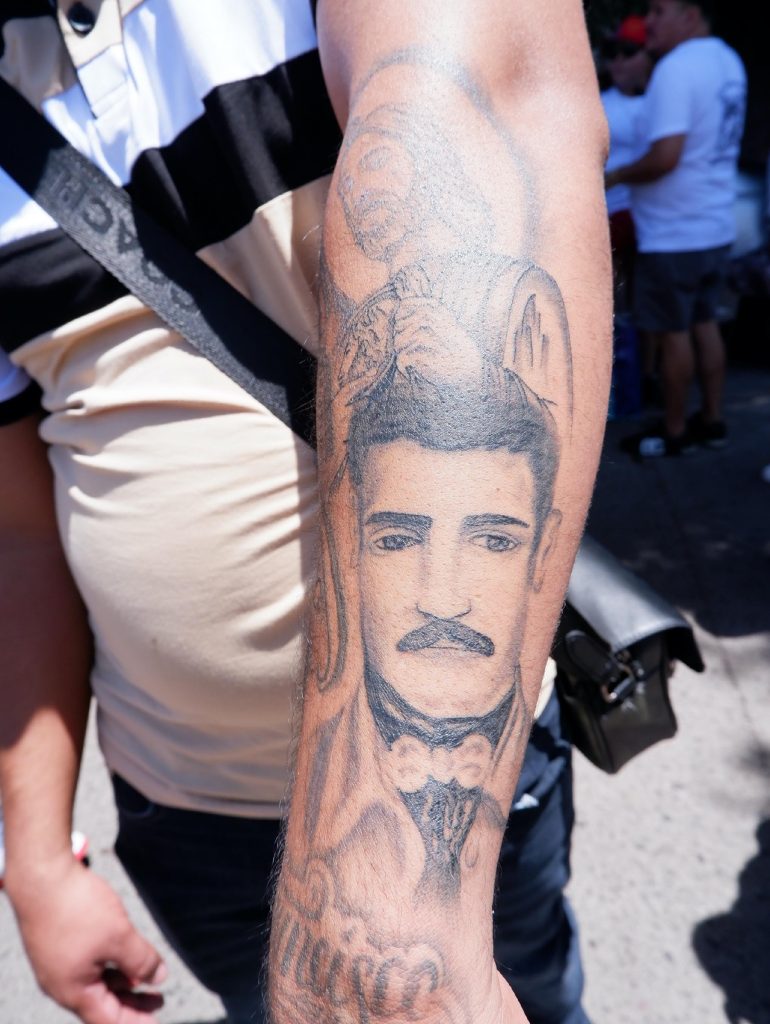
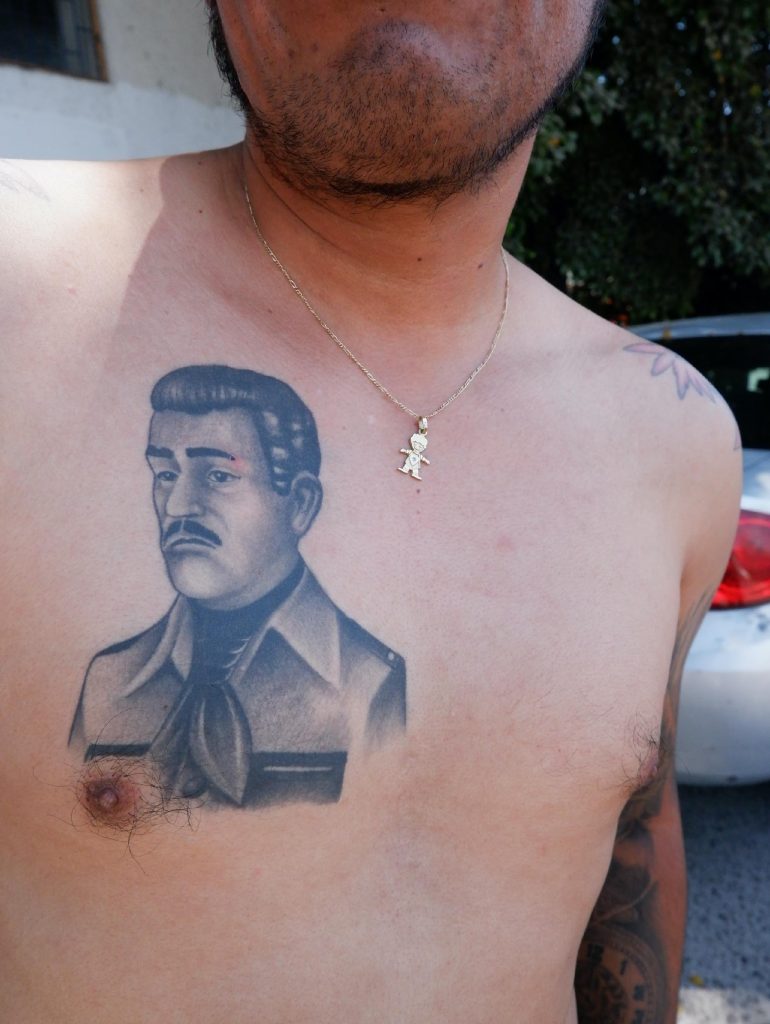
Image 9. Tattoos IV
Culiacán, Sinaloa, May 3, 2024
Regarding the tradition of the malverdista tattoo, here we can appreciate the spiritual practice in its maximum splendor. The devotee, bare-chested, shows his tattoo, still fresh; a work that has not yet finished healing, but which allows the bearer to be ready to fulfill his command. This photo shows a reproduction of the print that usually has the prayer to Malverde on the back. That is why both the tie and the denim shirt are in keeping with the description of the image in the main niche in the chapel.
Image 10. V tattoos
Culiacán, Sinaloa, May 3, 2024
Once again, a cargo carrier carrying his image of Malverde displays his tattoo on his forearm. Both the bust he carries and the image of his tattoo have a small bow and the same jacket; apparently, the latter has been copied from the former. The truth is that the constant tattoos on the forearm are a sign of tolerance and social acceptance of the devotion to Malverde. We cannot fail to point out that in the photo it stands out that he is spilling whisky to the figure.
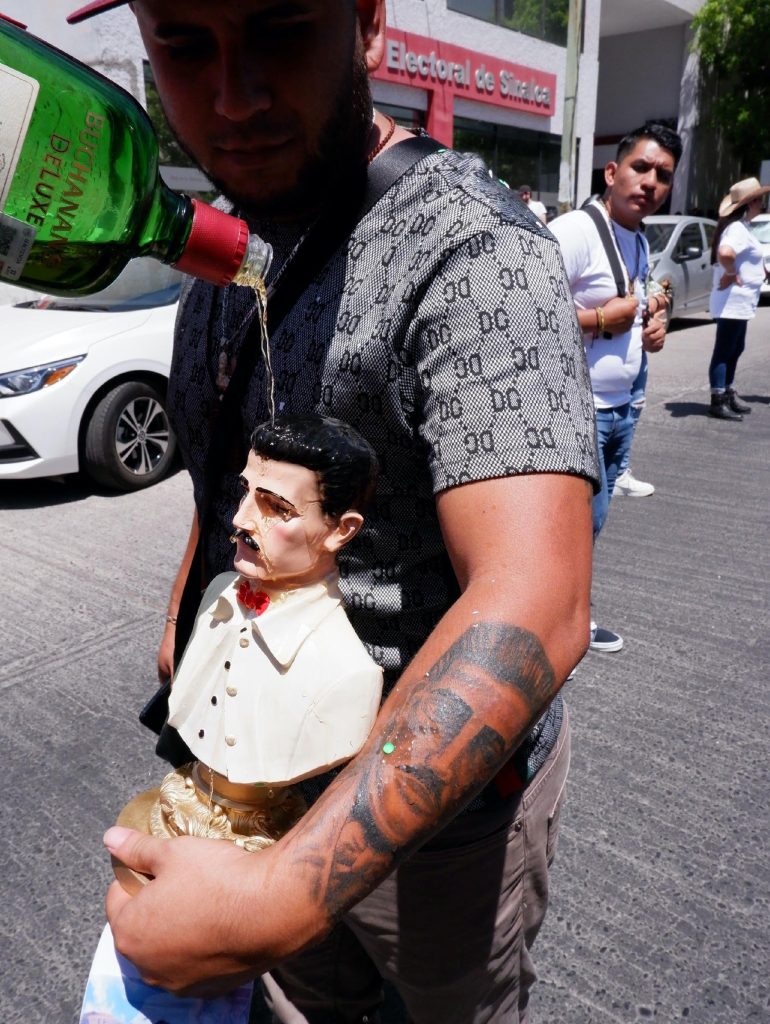
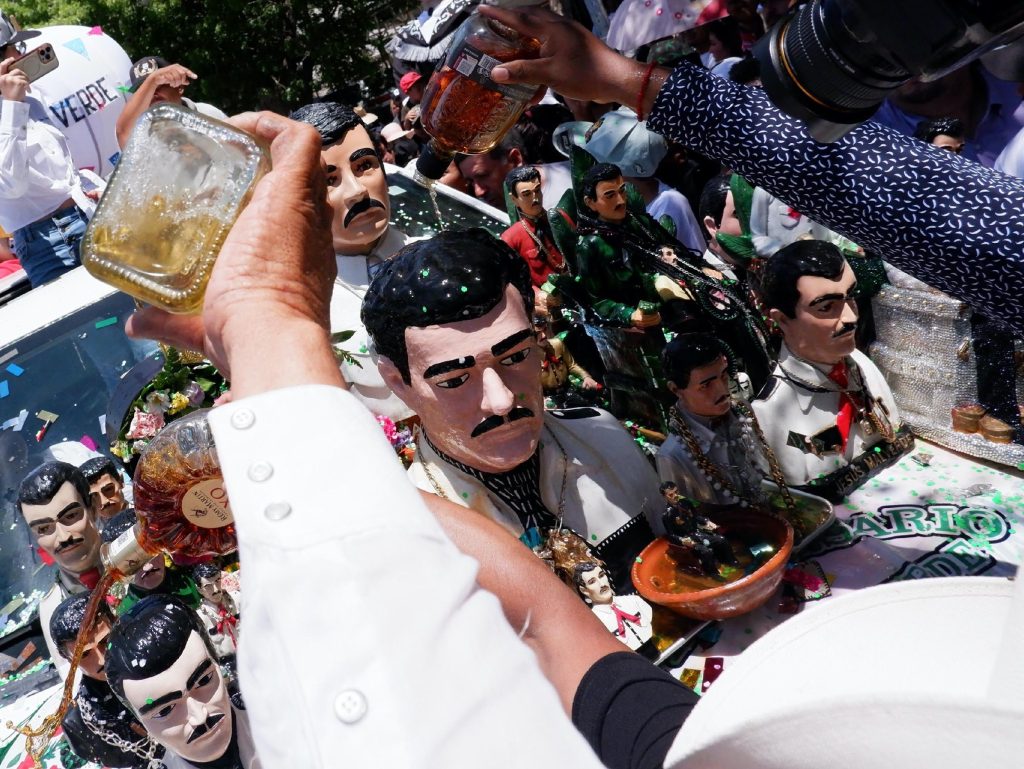
Image 11. Consecrations
Culiacán, Sinaloa, May 3, 2024
During the tour through the surrounding streets, the main image of Malverde is transported on the hood of a van owned by the chapel. This photo shows a group of religious images, medals, scapulars, etc., whose owners are adherents who walk alongside the truck. The practice of spilling alcoholic beverages on the images, usually whiskey or tequila, stands out. This spiritual practice, which is traditionally carried out year after year, is one of the most popular among the malverdistas adherents, reason why a lot of alcohol is spilled and the image is damaged, which must be repaired for the following year's tour.
Image 12. Consecrations II
Culiacán, Sinaloa, May 3, 2024
The image in the main niche, during the festivity, is easier to see or touch during the tour than being inside the chapel, since to visit it in its niche you have to wait in line and wait your turn to pass, which usually takes a long time. This exit allows to observe the authentic image together with different variations. In this photo a saint of white complexion is observed, with medium bushy eyebrows, without beard, with mustache. He wears a white denim shirt with black details and a black tie with white stripes.
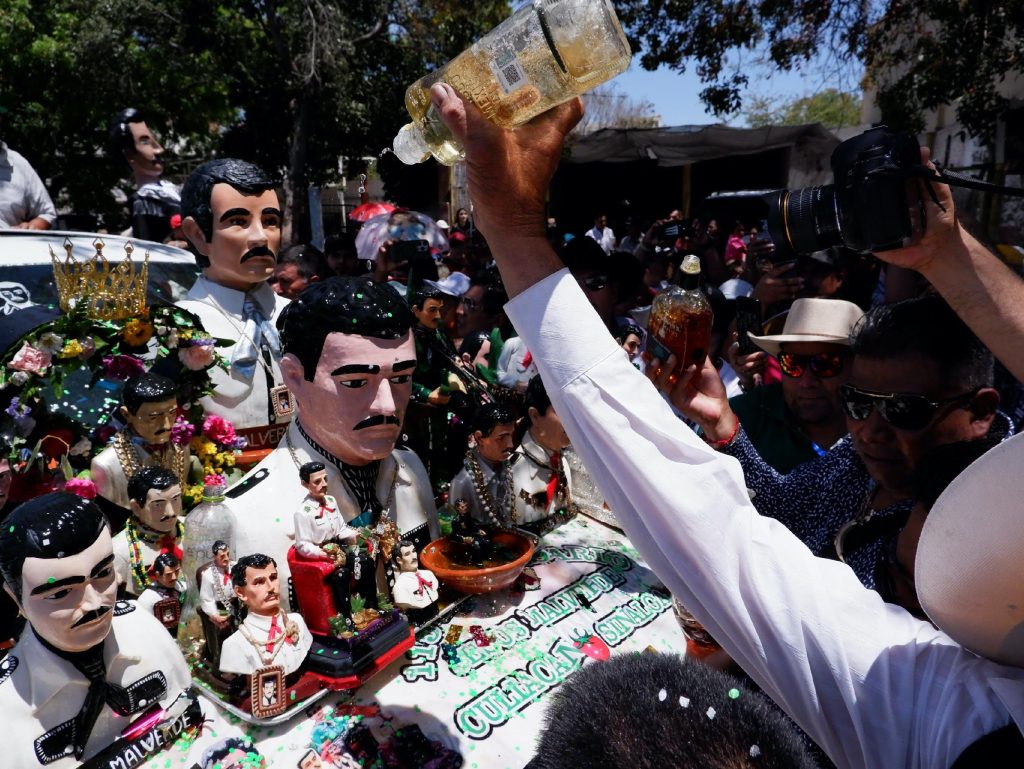
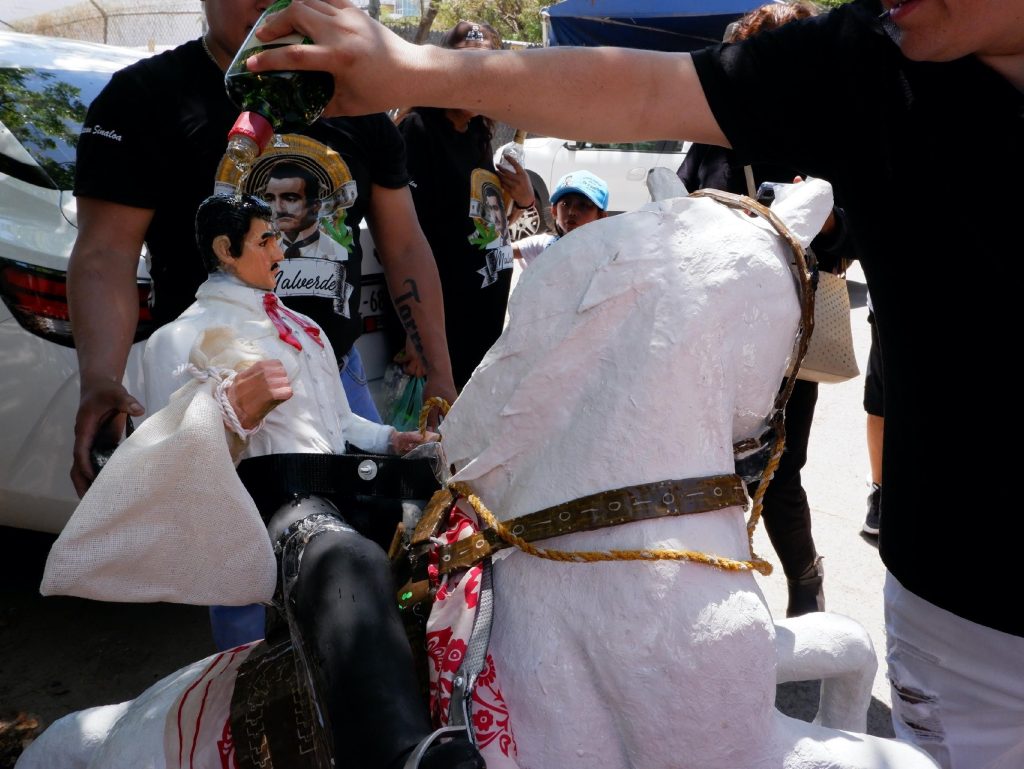
Image 13. Consecrations III
Culiacán, Sinaloa, May 3, 2024
The rider of Divine Providence riding his white horse is sacralized during the tour by another visitor who, taking advantage of the break, pours whiskey on his head. In previous years this practice was seen almost as an exclusive relationship between the chaplain and the main image, since he is usually the one who has been in charge of receiving the liquor from the devotees to pour it on the images and on the visitors themselves. This photo shows a full body Malverde wearing a red tie, white shirt and black pants. Likewise, it stands out that in his hand he carries a sack or bundle in allusion to the generous bandit that he represents.
Image 14. Consecrations IV
Culiacán, Sinaloa, May 3, 2024
Drinking liquor or using other substances in popular Catholicism and in Mexico is not something that is at odds with religious life. In Malverde's feast the adherents carry out this practice within the sacred field. This image shows a common way of sharing liquor among visitors participating in the dance, while waiting for the main image of Malverde to leave the chapel.
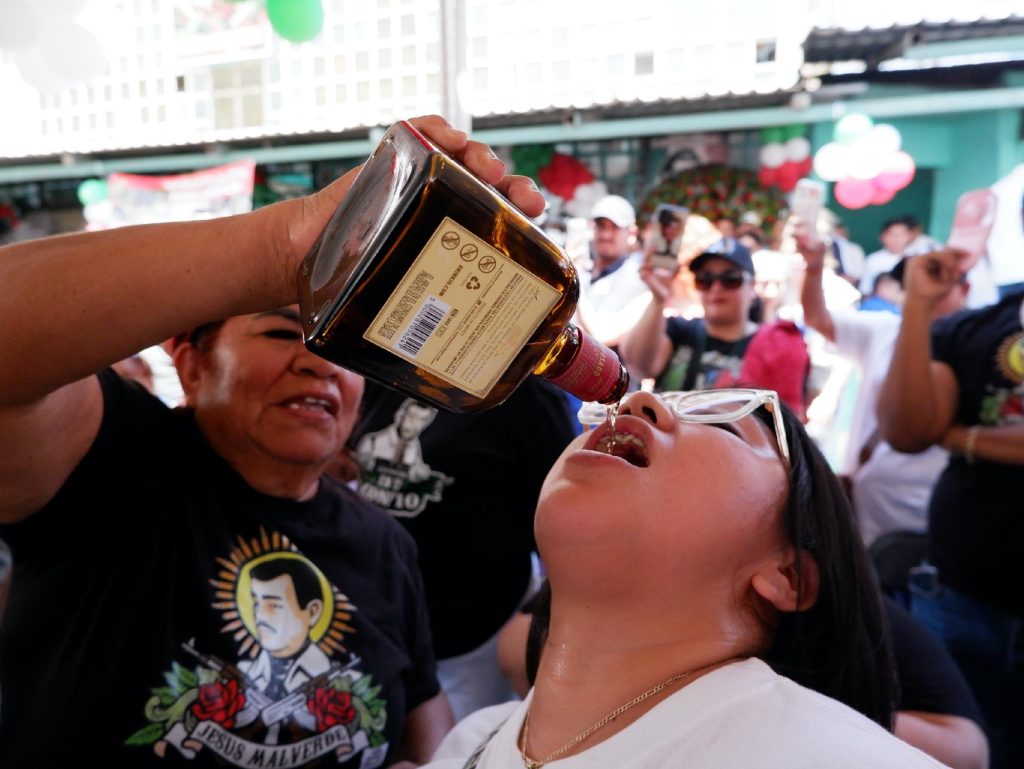
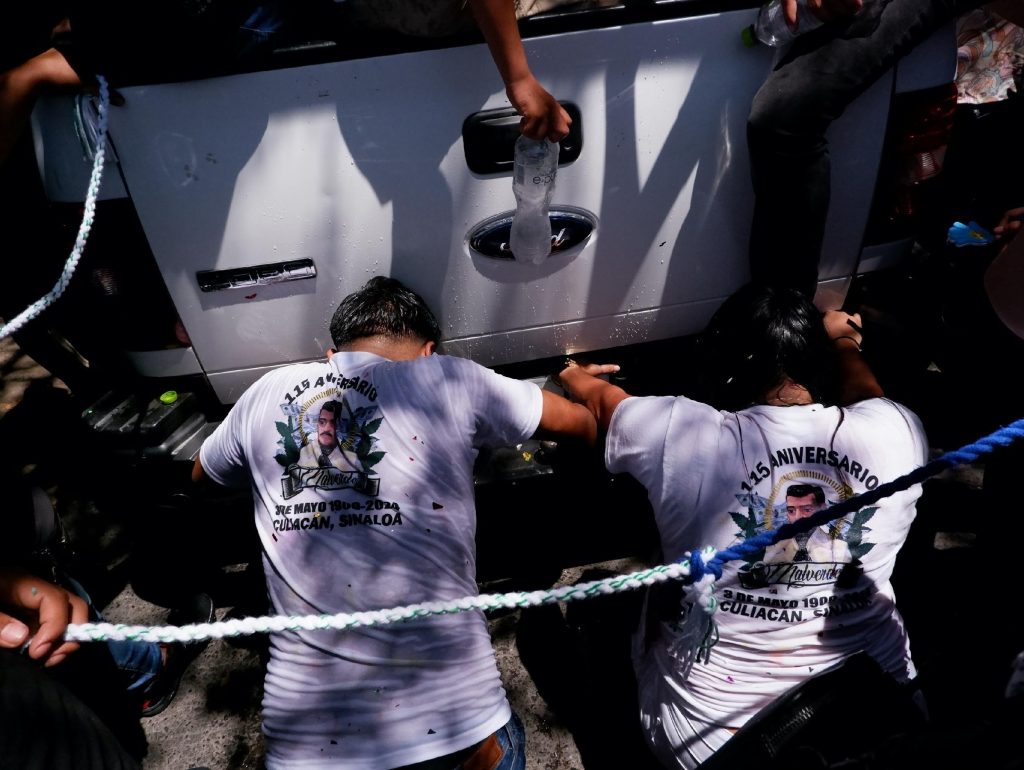
Image 15. Penance
Culiacán, Sinaloa, May 3, 2024
Physical sacrifices -such as pilgrimages barefoot or on one's knees- are common in Catholic devotion. In Mexico, on December 12, the day the Virgin of Guadalupe is celebrated, it is normal to see the Guadalupe faithful enter the Basilica on their knees as a sign of faith. In the case of the Malverde festivity, it is an uncommon spiritual practice that required certain care, due to the fact that, unlike the winter in Mexico City, the asphalt in Culiacán during the month of May is scorching hot. However, for Malverde devotees this is not an impediment. The photo shows two people kneeling in procession behind the truck carrying the main image of Malverde.
Image 16. Penance II
Culiacán, Sinaloa, May 3, 2024
Penance taken to the extreme of accepting physical punishment (self-inflicted) as a spiritual practice, despite being widely practiced, does not have the same acceptance within the Catholic Church, since there are less risky ways to achieve forgiveness. In this photo, two people are seen making the journey on their knees behind the main image of Malverde. Their faces cannot hide the physical pain. Their improvised knee pads, made from pieces of pants, reflect the urgency to reduce the impact of the concrete with each step they take. This photo also shows that their clothes are soaked with water as other devotees try to keep both the concrete and their bodies cool.
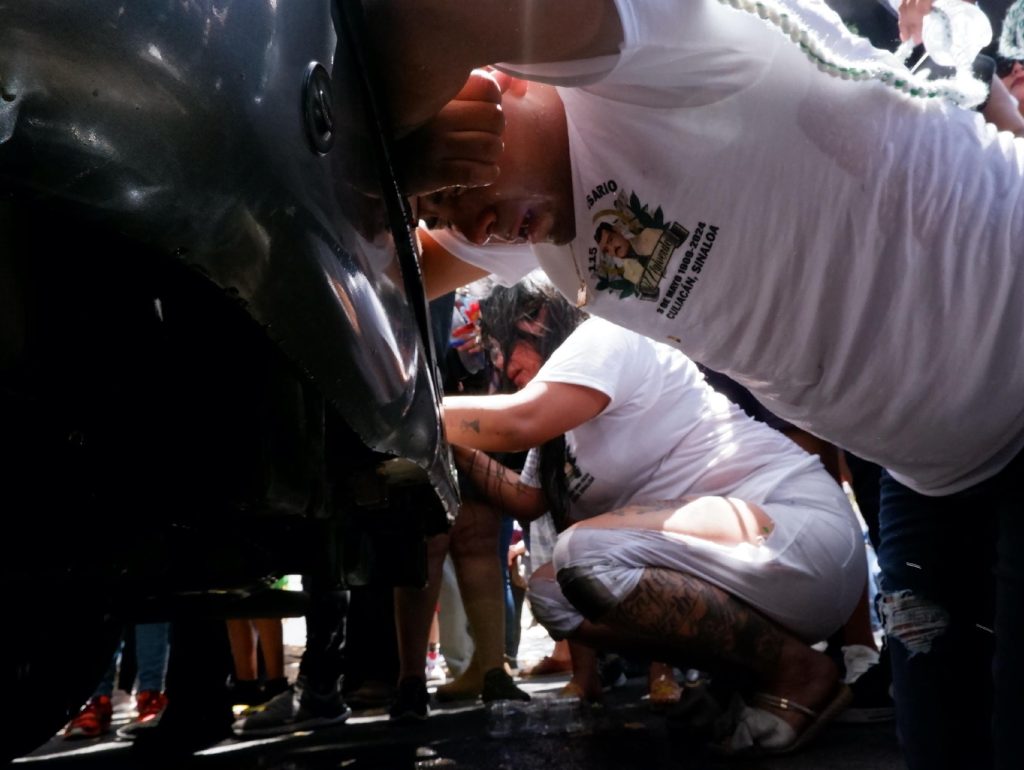
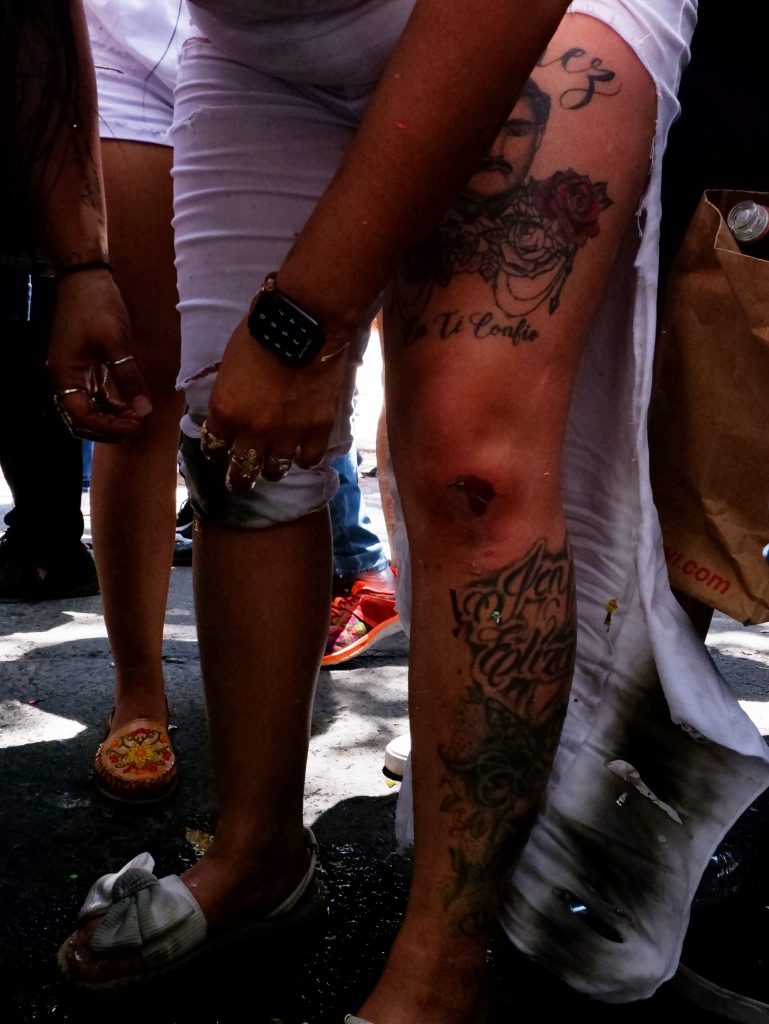
Image 17. Penance III
Culiacán, Sinaloa, May 3, 2024
While it is true that, due to the blood on the knee ground by the concrete, a superficial reading of this photo invites us to think of a person with self-inflicted wounds, it is also necessary to describe a couple of symbolic elements within it. The first, the tattoo of Malverde's face decorated with roses that the person wears on his thigh accompanied by the phrase "in you I trust", indicates that probably walking on his knees is not his first command fulfilled to the saint. The second, which refers to the consecration of the act, has to do with genuflection as a spiritual practice and as a Catholic penitential practice, taken to an extreme use in terms of popular practice.
Image 18. Malverde de las siete potencias (Malverde of the seven powers)
Culiacán, Sinaloa, May 3, 2024
This image stands out for its colorfulness. This bust, resting on the base of a pillar, exhibits in and on itself elements of another belief system. On the one hand, the shirt of the saint is dyed in seven colors, symbol of the seven powers or main deities of the Yoruba pantheon. On the other hand, on this Malverde there is a necklace of Elegguá, one of the main deities of the Yoruba religion, responsible for opening or closing the paths of its believers, as well as providing them with protection.
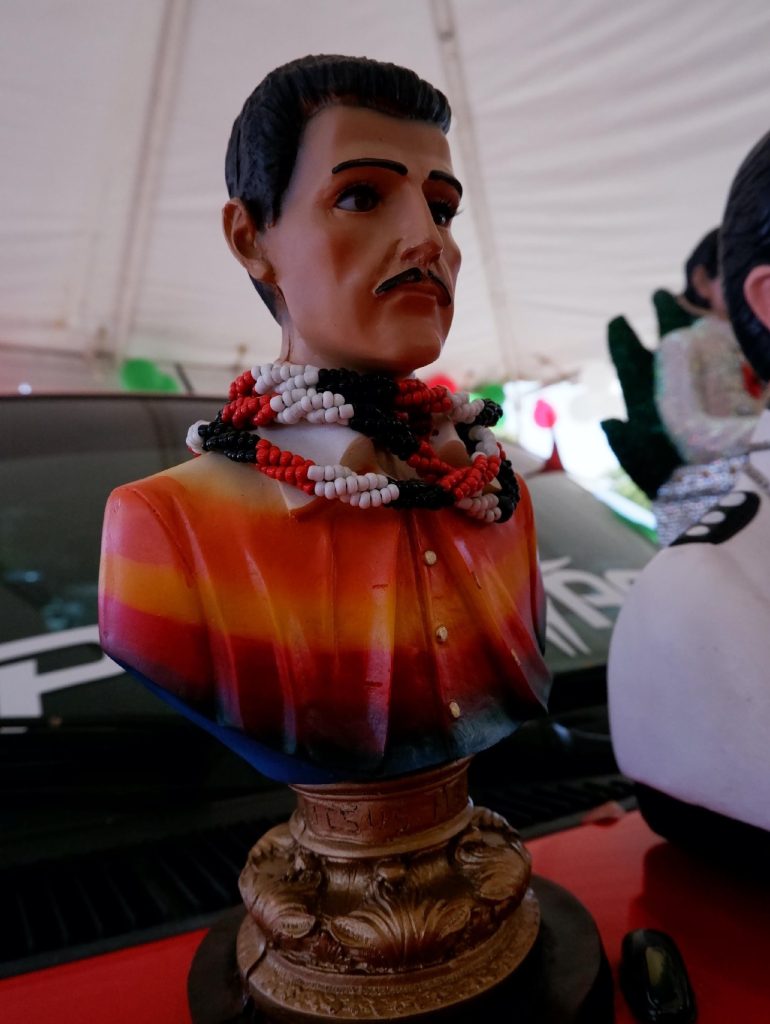
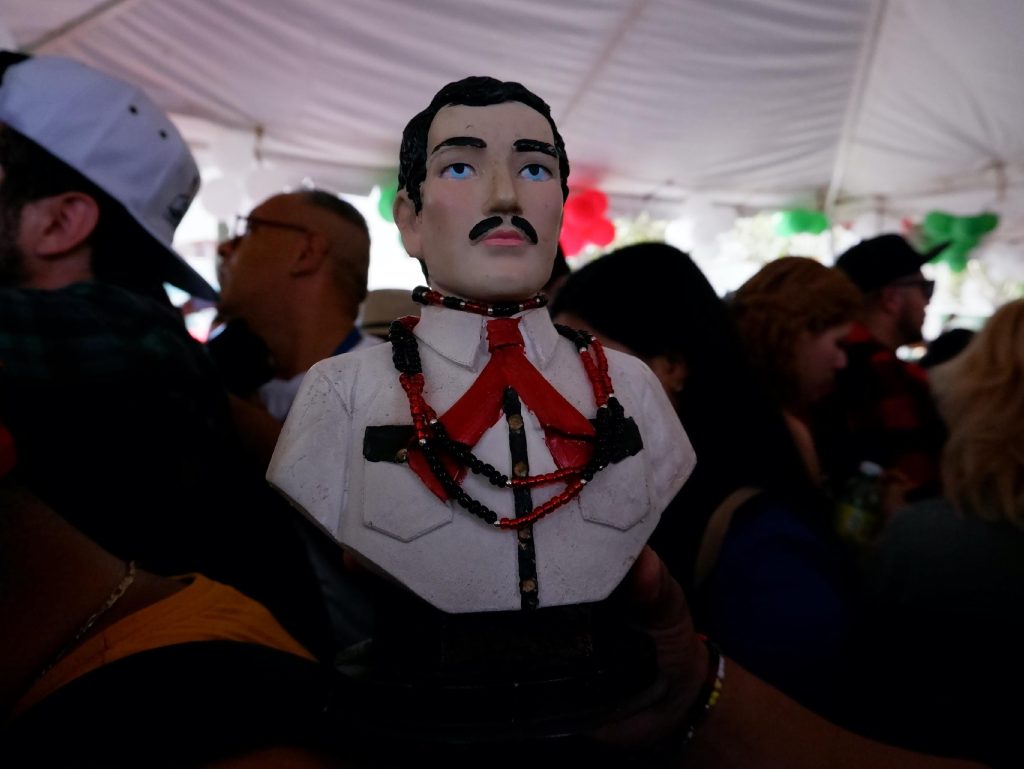
Image 19. Yoruba Malverde
Culiacán, Sinaloa, May 3, 2024
Since its adoption by Colombian and Mexican drug traffickers a few decades ago, the Yoruba or Santeria religion has become more present in the so-called narcoculture. Nowadays, more and more corrido singers, influencers and other personalities related to drug trafficking intertwine popular belief systems. Again, the photo shows the bust of Malverde, this time with blue eyes and slightly pink lips, wearing a red tie and denim shirt. Around his neck he wears a necklace of Elegguá, the main protective deity of the Yoruba pantheon. It is a constant that Malverde is related to Elegguá, since both are protector saints of their adherents.
Image 20. The bust and its carrier
Culiacán, Sinaloa, May 3, 2024
In addition to the devotees who seek to deposit a candle, some accessory or their personal images, either in the chapel or on the truck that leads the procession, during the celebration of May 3 it is common to see the cargueros carrying in their arms the images that regularly form part of their personal altars at home. This bust, in particular, is shown with variations such as the bushy eyebrow and red tie. A green rosary also stands out on the saint; possibly this color is also related to Orula, another deity of the Yoruba pantheon associated with wisdom.
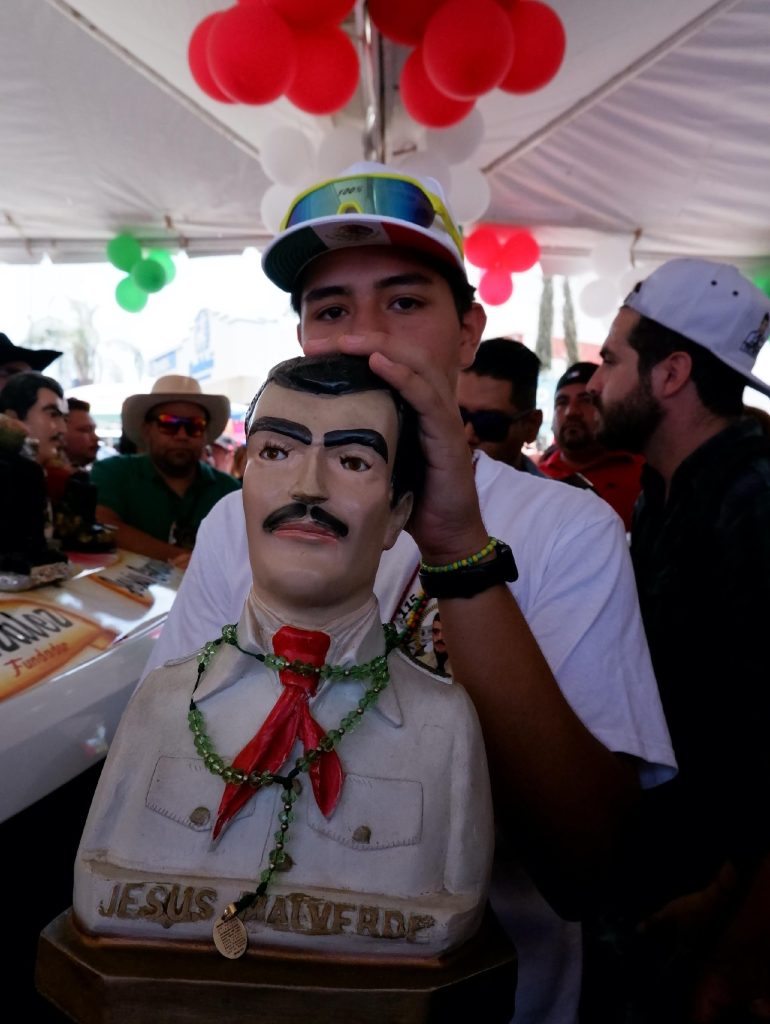
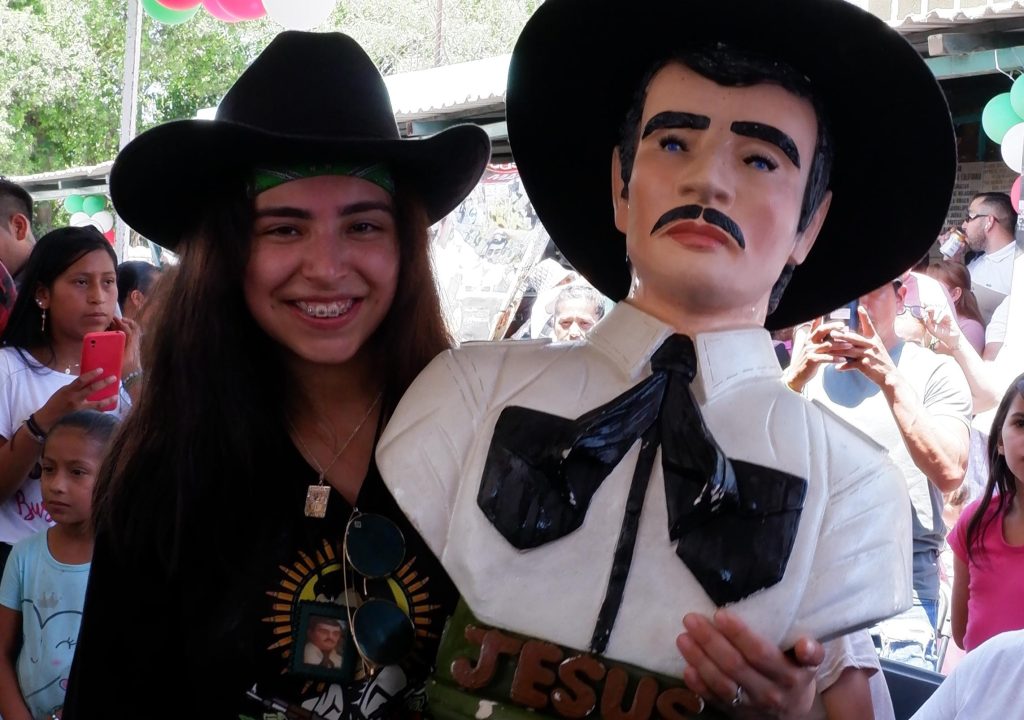
Image 21. Malverde's cargo carrier
Culiacán, Sinaloa, May 3, 2024
An image from the northeast of the country resting on a pillar base. In addition to highlighting the wide tie and for being decorated with a hat, this representation is characterized by blue eyes, false eyelashes, painted lips and blush on the cheekbones. In previous years, during the tour had highlighted the images of Malverdes pelones, a rapa, alluding to the cholos and homies from the State of Mexico. However, a feminized Malverde, inspired and molded by the life story of his carguera, is innovative. He transgresses the field of the sacralized masculine with a feminized sacralized image, which corresponds more to his own reality and his interpretative frameworks of spirituality.
Image 22. Amigurumi malverdista
Culiacán, Sinaloa, May 3, 2024
The devotees of Malverde, whose presence is more and more constant during the festivity, have introduced different innovations to the field of religious and spiritual practices and beliefs. In this photograph the carguera has substituted traditional materials such as plaster for the creation of her image. In its place she carries a Malverde made with the crochet technique. The character is seen in full body, with a red tie, a bud of cannabis and a bag of money in both hands. On the base where the character rests, coins are placed as an offering.
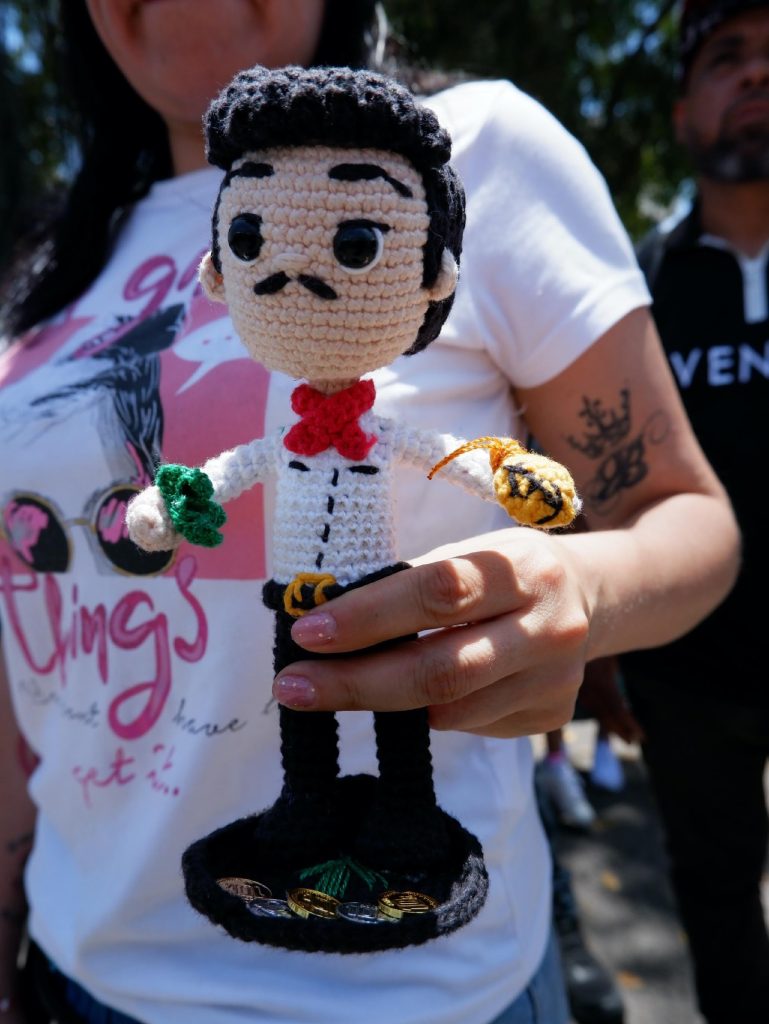
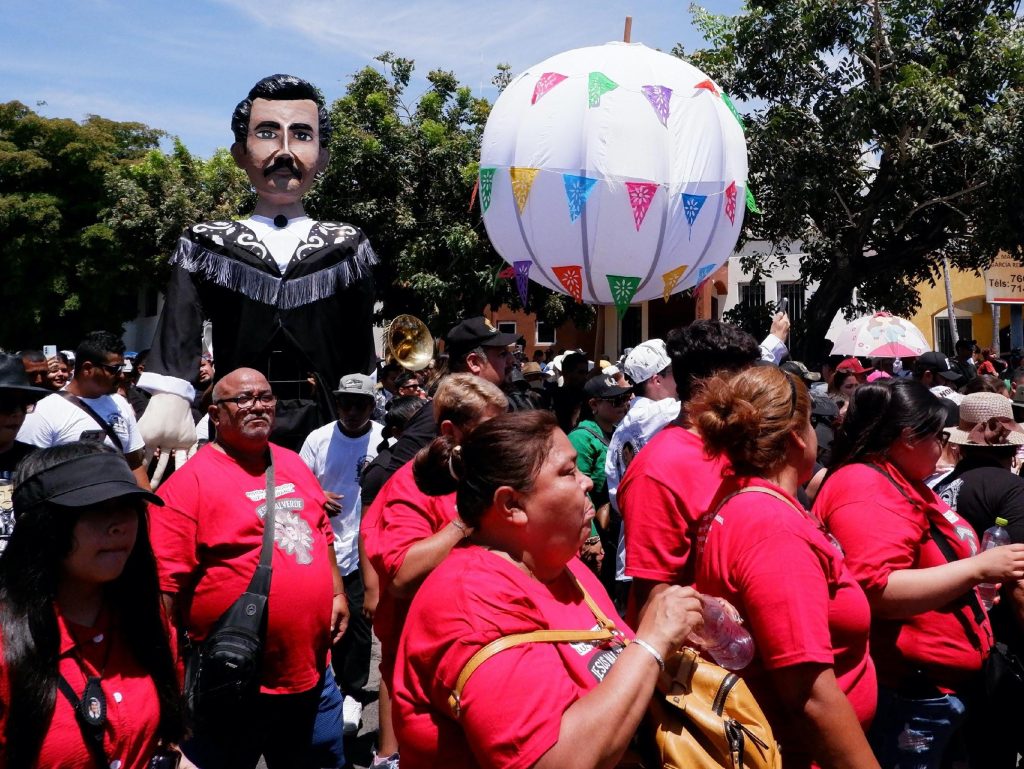
Image 23. Party objects and carnival malverdista
Culiacán, Sinaloa, May 3, 2024
This photograph shows a contingent of devotees of the Fidencista Luz y Esperanza Mission, dressed in red. In the background is a botarga and a carnival balloon. The representation of Malverde is different, more in the style of Tamaulipas, while the balloon is decorated with pennants.
Arturo Fabian Jimenez is a researcher and documentary filmmaker with extensive experience in the study of religious phenomena and popular religiosity in Mexico, as well as in the analysis of migration and violence against migrants in regions such as the Darien. She is a specialist in the analysis of unofficial cults and the production of salvation goods, with a particular focus on the figure of Jesus Malverde. Her work combines ethnographic and photographic methods to document and analyze the practices and beliefs of diverse religious communities. In addition, she has researched and documented the plight of migrants through video documentary production to capture their experiences and make visible the violations of their human rights. She has presented her research at national and international conferences and has published several articles in specialized journals, providing a more comprehensive and accessible view of religious and migratory dynamics in contemporary contexts.
